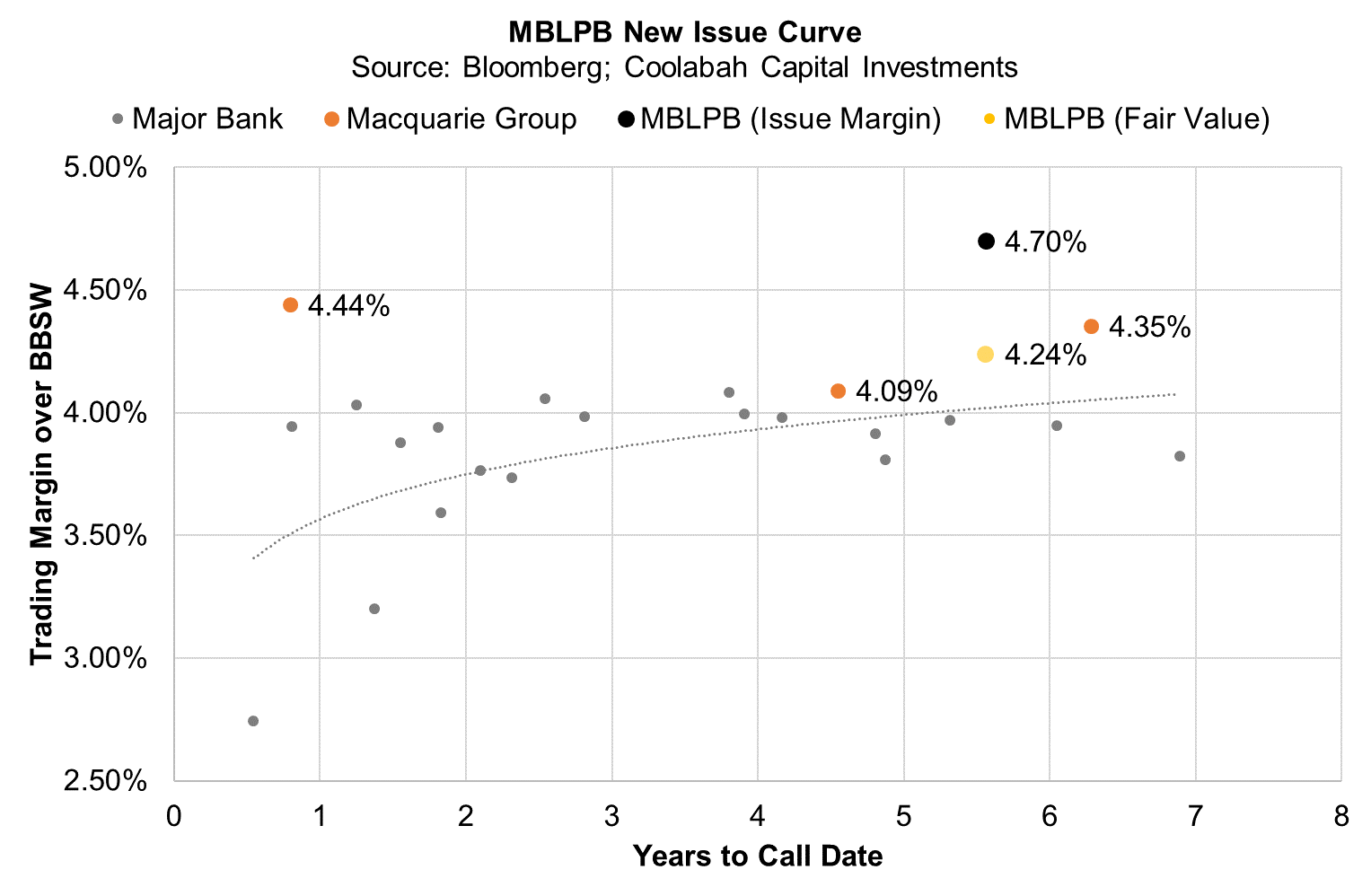Macquarie hybrid soars, Genworth pulls bond issue, and housing bears run for hills
As we had projected here days ago, Macquarie's new hybrid security (ASX: MLBPC - it was initially marketed as MBLPB) listed on the ASX at a massive premium to face value, trading up from its $100 issue price to as high as $103 (we bought a decent chunk in the original deal). That represents tremendous spread compression from the issue margin of 4.7% above the quarterly bank bill swap rate (BBSW) to around 4.1% (ie, a 60 basis point reduction). Regular readers might recall that I recently presented our analysis forecasting that MBLPC's price would rise from $100 to up to $102.57, and it did not fail to disappoint. Specifically, I wrote:
Based on Friday's ASX pricing, it looks like the interpolated credit spread for MBLPC would be around 4.24% above the swap rate (given it sits between two other Macquarie Group hybrids---MQGPC and MQGPD---in terms of tenor), which suggests a clean price of about $102.11 (or a capital gain of more than 2% above its $100 face value) in lieu of the 46 basis points of prospective credit spread compression from the 4.7% issue margin...
If investors were to price in this superior creditworthiness (ie, the higher rating) by, say, reducing MBLPC’s trading margin 10 basis points tighter than its currently interpolated spread using the Macquarie Group hybrid curve (ie, down from 4.24% to 4.14%), this would increase the expected clean price $0.46 to $102.57.
While MBLPC now seems fully priced on a relative cross-sectional basis, we believe there is still a lot of upside on a bottom-up outright fundamentals basis given our expectation that the major banks' five-year hybrid curve will compress towards its pre-crisis levels around 270bps over BBSW (vs current levels at circa 394bps). Assuming, for example, an 8.8% probability of default and a 0% recovery rate, we have the minimum fair value required return for a five-year major bank hybrid at about 184bps over BBSW before any considerations around liquidity risk premia.

Genworth First Loss Piece Pulled
The other big news yesterday was that the mortgage loss insurer Genworth was forced to pull its Tier 2 subordinated bond issue even after the joint lead managers had confidently broadcast that there was $200 million of indicative interest for the deal at a proposed credit spread of 500bps over BBSW. We had zero interest for two reasons:
- In contrast to all other Tier 2 bonds issued by listed banks, Genworth's security does not convert into its listed equity in a default event (specifically, when APRA declares that Genworth has reached the point of non-viability). Instead, this security bizarrely gets zeroed, or written off completely. Genworth had previously issued equity-converting Tier 2, but moved to the full write-off structure with their previous issue. When I quizzed the company at the time on why they would not allow the bond to be converted into equity in default (as had previously been the case), I was told that Genworth's largest shareholder, its US parent company, did not want to suffer equity dilution in such a scenario. In short, Genworth is saying that it wants bondholders to be wiped out before its shareholders have to wear any pain, which means that Genworth's Tier 2 bond is effectively subordinated to equity. It is therefore the first-loss piece;
- This brings me to my second concern. Genworth is providing first-loss insurance for residential mortgage lenders in the event their borrowers default and cannot repay their loans. Setting aside debate around the state of the housing market right now (see below), we know that the first loss equity tranche in warehouses funding home loans are generally demanding returns of around 10%. So why would anyone be stupid enough to accept a 5% return from a the first-loss equity tranche that is effectively going to be forced to wear all the risk in any non-viability event? The obvious answer is that when investors really thought about it, they decided that was indeed a dud trade at its proposed price. If Genworth were to re-rack the spread wider to, say, 1000bps, I might have interest.
Housing Bears Running for the Hills
Yesterday we had the first of the housing bears caught in our cross-hairs: the once-grizzly UBS conceded:
"Looking forward, we had expected home prices could drop 10%, but it could be smaller now. We await policy details to review our outlook"
Yeah, the bears are gonna start running for the hills when they realise the wolverine is about to BBQ them. Expect lots of moaning, groaning and endless excuses. They will all likely roll out the ole "Steve Keen". "Oh, but if it were not for low interest rates and stimulatory fiscal policy and other counter-cyclical stuff, we would have been right!"
"When we first looked at the impact of the intensifying shutdown of the Australian economy on the housing market...the risk was that a deeper downturn with say 10% unemployment could see a 20% fall in prices". Oliver continues: "Subsequent government support measures along with an earlier reopening of the economy have reduced the risk of worse case scenarios for home prices. Our worst-case scenario for a 20% decline in prices and those of others seeing 30% plus falls are unlikely thanks to support measures and the earlier reopening of the economy."
In more bad news for the bears, CoreLogic's daily index has increased for two days consecutively in Sydney, Melbourne and across the 8 capital cities (yes, I know that is not much to get excited about)...This debate is ultimately an empirical question, and I am having fun with it in the meantime!
Never miss an update
Stay up to date with my content by hitting the 'follow' button below and you'll be notified every time I post a wire. Not already a Livewire member? Sign up today to get free access to investment ideas and strategies from Australia's leading investors.
3 topics

